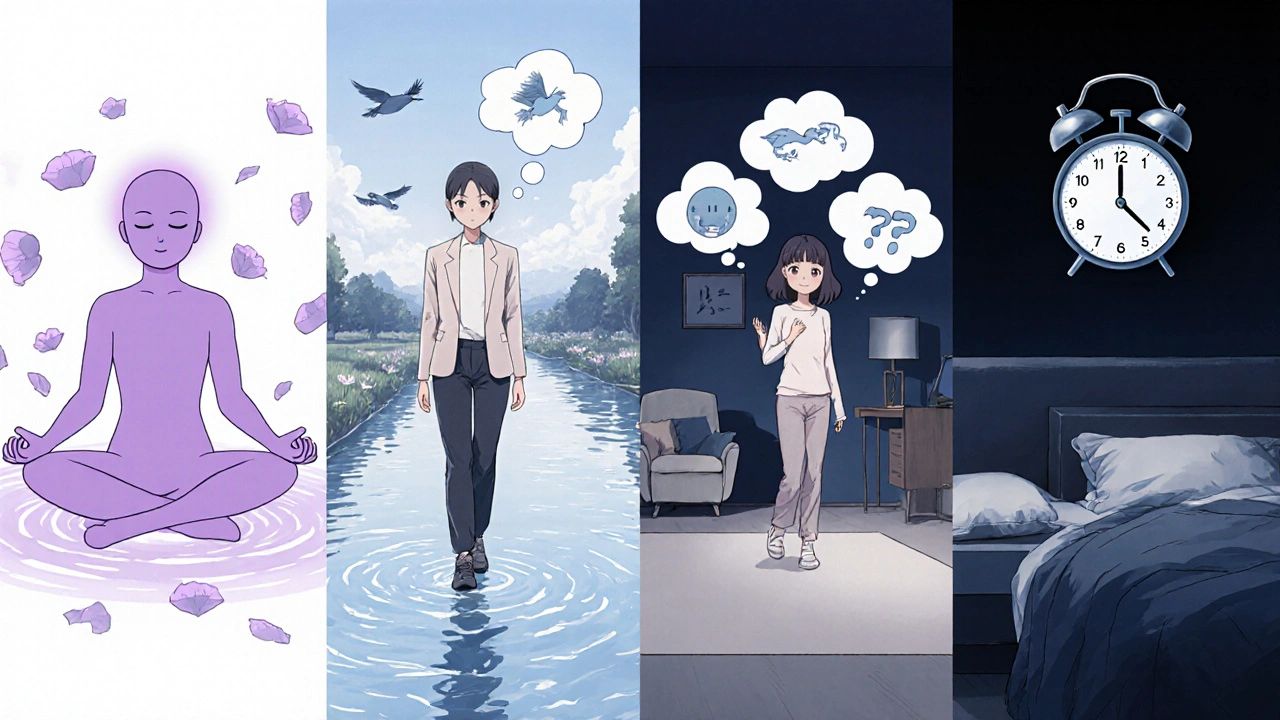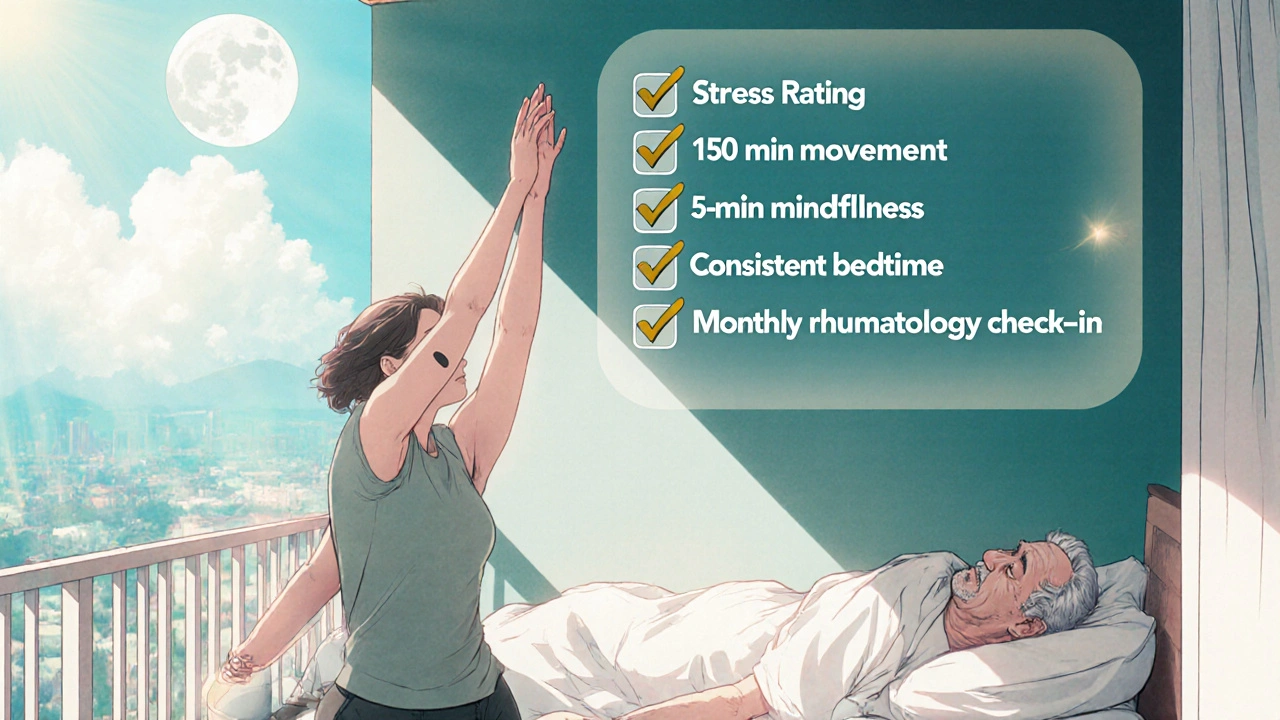Imagine waking up with swollen hands, a throbbing joint ache, and the same old prescription bottle on the nightstand. You’ve tried the usual meds, but the flare‑ups keep coming. What if the missing piece isn’t another drug at all, but the way you handle everyday tension?
Rheumatoid Arthritis (RA) is a chronic autoimmune disease that attacks the lining of joints, causing pain, stiffness, and long‑term damage. While disease‑modifying drugs are essential, research increasingly shows that stress management in rheumatoid arthritis can tip the balance between frequent flares and a steadier, more comfortable life.
Why Stress Matters for RA
Stress isn’t just a feeling; it triggers a cascade of hormones that directly influence the immune system. When you’re under pressure, the adrenal glands release Cortisol, a hormone meant to calm inflammation in short bursts. Chronic stress, however, leads to cortisol resistance, meaning the body can’t shut down inflammation effectively. The result? Higher levels of Inflammation that fuel joint swelling and pain in RA patients.
Studies from the University of Toronto (2023) showed that patients with high perceived stress had 30% more swollen joints than those reporting low stress, even when medication adherence was identical. The takeaway is clear: managing stress isn’t a nice‑to‑have extra-it’s a core component of RA care.
Core Stress‑Management Techniques That Work for RA
Not every relaxation method is created equal for people battling RA. Below are four evidence‑based approaches that target the cortisol‑inflammation loop while being joint‑friendly.
- Mindfulness Meditation: A daily 10‑minute seated practice reduces the perception of pain and lowers serum C‑reactive protein (CRP) by up to 15% (JAMA, 2022). The key is consistency, not length.
- Physical Activity: Low‑impact aerobic exercises-walking, swimming, or stationary cycling-improve joint range of motion and release endorphins that blunt stress signals. A 12‑week program at the Mayo Clinic cut morning stiffness by 45 minutes on average.
- Cognitive Behavioral Therapy (CBT): Structured sessions teach patients to reframe catastrophic thoughts about disease progression. In a 2021 RCT, CBT participants reported a 20% drop in the Visual Analogue Scale for pain.
- Sleep Hygiene: Quality sleep restores cortisol rhythms. Simple steps-no screens after 9 p.m., a cool dark room, and a consistent bedtime-can reduce night‑time flare frequency by 25%.
How to Build a Personal Stress‑Management Plan
- Assess Your Stress Baseline: Use a brief questionnaire like the Perceived Stress Scale (PSS). Record scores, joint pain, and fatigue for a week.
- Pick One Primary Technique: Start with the method that feels most doable. If you hate sitting still, choose Physical Activity; if you’re a night owl, begin with Sleep Hygiene.
- Set Micro‑Goals: Example - “Walk 15 minutes after lunch, three days this week.” Write them in a journal or phone app.
- Integrate a Mind‑Body Component: Pair your primary goal with 5 minutes of Mindfulness Meditation after each session.
- Track Outcomes Weekly: Note changes in joint swelling, pain score, and mood. Adjust the plan if you’re not seeing improvement after four weeks.
- Seek Professional Support: A rheumatologist can coordinate stress‑management with medication adjustments, while a therapist can fine‑tune CBT techniques.

Comparing Stress‑Management Techniques for RA
| Technique | Impact on Pain (VAS) | CRP Reduction | Joint Mobility Gain | Adherence Ease |
|---|---|---|---|---|
| Mindfulness Meditation | -12%* | -15% | +5° flexion | High |
| Physical Activity (low‑impact) | -20% | -10% | +15° flexion | Medium |
| Cognitive Behavioral Therapy | -18% | -8% | +7° flexion | Low (requires therapist) |
| Sleep Hygiene | -10% | -12% | +4° flexion | High |
*Percent change compared to baseline after 8 weeks of consistent practice. Numbers are averages from multiple peer‑reviewed trials.
Real‑World Success Stories
Maria, 48, was diagnosed with RA five years ago. Her doctor added a weekly yoga class and a 10‑minute nightly meditation routine. Within three months, her DAS28 (Disease Activity Score) dropped from 5.6 to 3.9, allowing her to taper down her daily NSAID dose.
James, 62, struggled with sleep‑related flares. After redesigning his bedroom environment and establishing a strict bedtime, his morning joint stiffness shrank from two hours to under 30 minutes. He now reports feeling “more in control” of his disease.

Pitfalls to Avoid
- Over‑exertion: Jumping straight into high‑impact workouts can worsen joint damage. Start low and progress gradually.
- One‑size‑fits‑all mindset: Not every patient benefits equally from a single technique. Mixing approaches often yields the best result.
- Neglecting medication: Stress‑management supplements, not replaces, disease‑modifying antirheumatic drugs (DMARDs) or biologics.
- Skipping follow‑up: Regular check‑ins with your rheumatologist ensure that stress‑reduction benefits are reflected in labs and imaging.
Quick Checklist for Busy Patients
- ✅ Complete a weekly stress‑rating survey.
- ✅ Move for at least 150 minutes a week (walk, swim, bike).
- ✅ Practice 5‑minute mindfulness after each movement session.
- ✅ Keep a consistent bedtime-no screens after 9 p.m.
- ✅ Schedule a 15‑minute check‑in with your rheumatology team each month.
Frequently Asked Questions
Can stress management replace my RA medication?
No. Stress‑reduction tools work alongside medication. They can lower the required dose or improve response, but they don’t treat the underlying autoimmune process by themselves.
How long before I see benefits?
Most patients notice reduced morning stiffness and lower pain scores after 4-8 weeks of consistent practice. Lab markers like CRP may take a bit longer.
Is mindfulness safe for people with joint pain?
Yes. Mindfulness is a seated or lying practice that doesn’t stress the joints. It’s actually recommended as a low‑impact way to manage pain.
Do I need a therapist for CBT?
While some CBT programs are available online, a trained therapist can tailor strategies to RA‑specific worries, making the approach more effective.
What if I can’t fall asleep even after better hygiene?
Consider a short, physician‑approved melatonin regimen or discuss other sleep‑aid options with your rheumatologist. Sleep is a cornerstone of stress control.
Integrating stress‑management into your RA routine isn’t a quick fix-it’s a steady habit that reshapes how your body reacts to inflammation. By pairing these tools with the right medication, you give yourself the best shot at fewer flares, better joint function, and a life that feels less dominated by pain.


Suryadevan Vasu
October 22, 2025 AT 16:33Stress management isn’t a cure, but it’s a useful adjunct to rheumatoid arthritis therapy.
Rachael Turner
November 1, 2025 AT 13:26The mind‑body connection feels like a quiet river that can smooth jagged stones of inflammation. When you notice tension building you can pause and breathe, letting the nervous system settle. It isn’t magic, just a way to give your body a chance to reset its own defenses. Over time that small habit can lower flare frequency without adding a pill. Think of it as a gentle tide that erodes pain more steadily than sudden waves.
Vin Alls
November 11, 2025 AT 09:33Imagine your immune system as an over‑excited orchestra, each instrument blaring louder than the next, and stress as the conductor who keeps waving the baton wildly. When that conductor gets frantic, the strings (your joints) start screeching, the brass (inflammatory cytokines) blare, and the whole performance turns into a chaotic jam. By introducing mindfulness, you hand the baton back to a calmer maestro, letting the sections play in harmony. A daily ten‑minute meditation is like tuning a violin-subtle, but essential for melodic health. Physical activity, especially low‑impact swimming or cycling, is the rhythmic percussion that keeps the beat steady, releasing endorphins that act as gentle placates for the angry crowd of immune cells. Cognitive Behavioral Therapy is the sheet music rewrite, re‑framing catastrophic thoughts and turning the melody from minor to major. When you pair these practices with proper sleep hygiene-cool, dark rooms and screen‑free evenings-you give the nervous system a night shift to repair and recalibrate. Studies show CRP can drop by up to fifteen percent, a measurable whisper of reduced inflammation that translates to fewer swollen joints. Over weeks, the cumulative effect of these habits can be profound: morning stiffness shortens, pain scores dip, and the overall disease activity score slides downwards. Think of it as building a layered armor-each technique adds a plate, and together they deflect the relentless onslaught of flare‑ups. Consistency beats intensity; a modest routine performed daily outweighs occasional marathon sessions. Tracking your stress levels with the Perceived Stress Scale can provide a feedback loop, highlighting what works and where you need to adjust. Journaling your progress creates a narrative of triumph, reinforcing the mind‑body alliance. And never forget the importance of communication with your rheumatologist; they can fine‑tune medication doses as your stress‑management gains momentum. In the grand concert of RA care, stress reduction isn’t a solo act but a crucial section that harmonizes with pharmacology. So grab that metaphorical baton, tune your instruments, and let the symphony of your body play a calmer, healthier tune.
Tiffany Davis
November 21, 2025 AT 05:40Thanks for laying it out so clearly. I’ve started with the 5‑minute mindfulness after my evening walks and already notice my joints feel less stiff. It’s helpful to keep the goals tiny-like “walk 10 minutes after lunch”-so it doesn’t feel overwhelming.
Don Goodman-Wilson
December 1, 2025 AT 01:46Oh great, another “miracle” list of yoga poses and breathing tricks. As if we need more fluff while pharma keeps raising prices. Sure, try meditating while your meds fail to stop the damage.
Bret Toadabush
December 10, 2025 AT 21:53Yeah right, they’re probably in cahoots with the big pharma lobbies, pushing mindfulness as a distraction while they hide the real cure. Remember the 1998 suppression of the immune‑modulating peptide? The same folks are behind this “stress” hype.
Diane Thurman
December 20, 2025 AT 18:00These techniques are just trendy band‑aid, not real science.